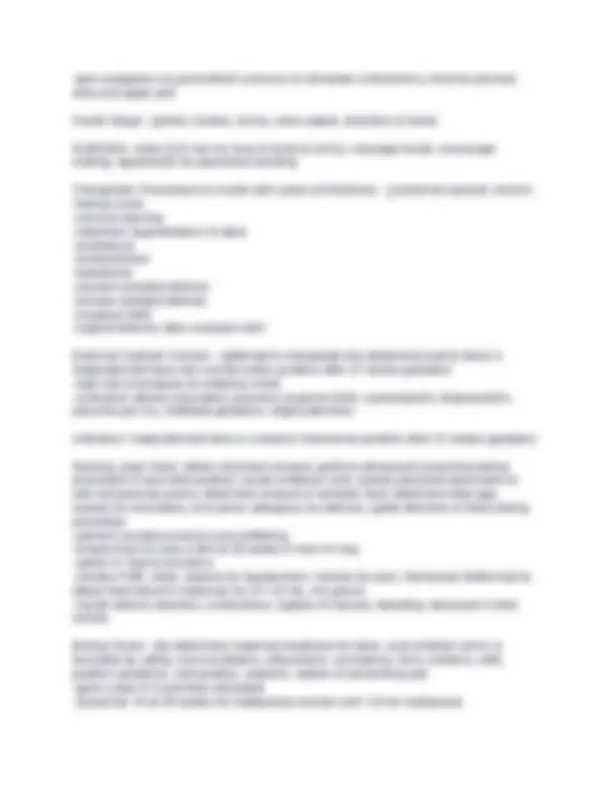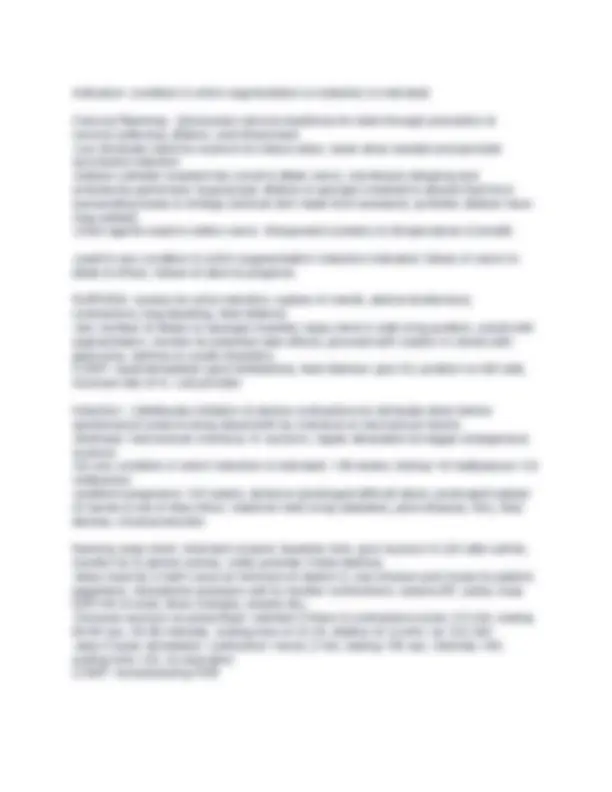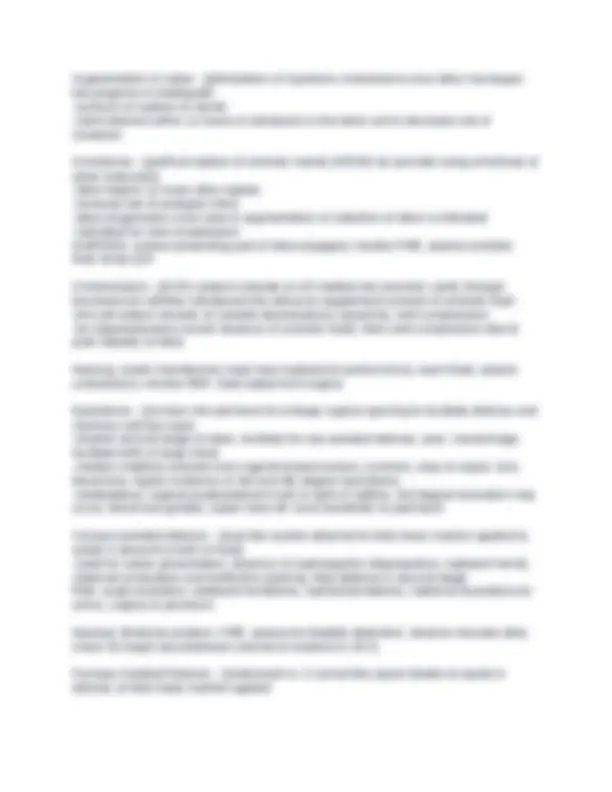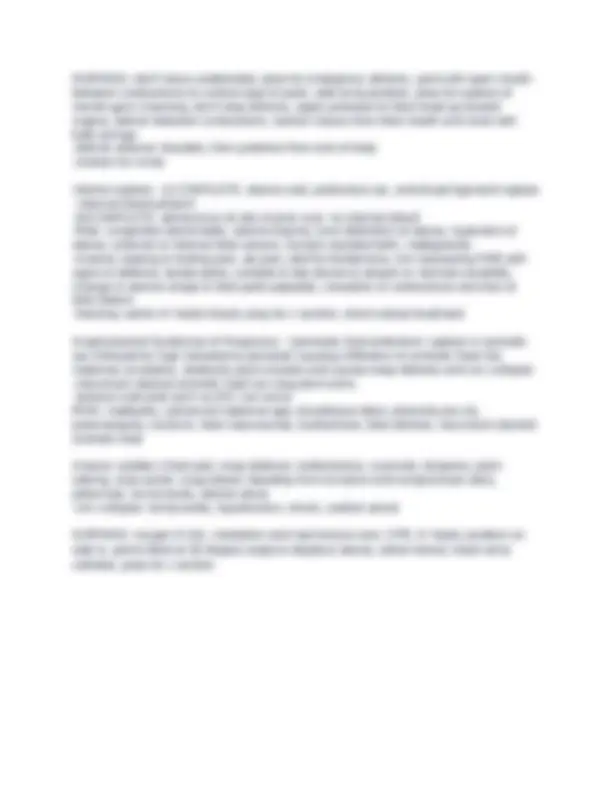






Study with the several resources on Docsity

Earn points by helping other students or get them with a premium plan


Prepare for your exams
Study with the several resources on Docsity

Earn points to download
Earn points by helping other students or get them with a premium plan
Community
Ask the community for help and clear up your study doubts
Discover the best universities in your country according to Docsity users
Free resources
Download our free guides on studying techniques, anxiety management strategies, and thesis advice from Docsity tutors
ATI Maternity chapter 14-16 Study Guide.
Typology: Exams
1 / 8

This page cannot be seen from the preview
Don't miss anything!





Nursing Care During Stages of Labor - ✅4 stages Nursing responsibilities: orient partner & patient to unit -provide culturally competent care that respects cultural care -conduct admission history & labor -monitor baseline fetal heart tones and uterine contractions pattern for 20-30 min -obtain vitals, and check status of amniotic membrane -perform assessment throughout labor and right after birth -avoid vaginal exams in the presence of vaginal bleeding or until palcenta previa or abruptio is ruled out -cervical dilation is most important indicator of progress -progress of labor is affected by fetal lie, presentation, attitude and fetal size in relationship to mothers pelvis -frequency, duration and strength of uterine contractions cause fetal descent and cervical dilation Cultures - ✅-Hispanic: prefer mom to be present rather than partner -African American: prefer female family member for support -Asian: prefer mom to be present. partner not active participant. labor in silence. c section undesireable -Native American: prefer female nursing personel, family involved, use of herbs during labor, squat for birth -European American: birth is public concern, focus on technology, partner expected to be involved, provider seen as head of health team First Stage of Labor - ✅-leopold maneuver performed -perform a vaginal exam as indicated to allow examiner to assess whether client is in true labor and whether membranes have ruptured -encourage the client to take slow, deep breaths prior to vaginal exam -monitor the dilation and effacement -monitor station and fetal presentation -prepare for impending delivery as the presenting part moves into positive stations and begins to push against pelvic floor -bladder palpation on regular basis to prevent bladder distention -BP, pulse and resp measurements: latent phase every 30-60, active every 30, transition 15- -temp every 4 hours -contraction: latent 30-60 active 15-30, transition 10- -FHR monitoring 110-160 normal Assessment of Membrane Rupture - ✅FHR to ensure there is no fetal distress for possible umbilicl chord prolapse -ph 6.5-7. -sampel of fluid: color clear straw and free of odor
-presence of meconium, abnormal color or odor is bad Nursing Intervention During First Stage - ✅teaching about what to expect during labor and relaxation measures: breathing (deep cleansing breaths) -effleurage (gentle circular stroking of abdomen in rhythm with breathing during contractions) -diversional activities (distraction, concentration on a focal point, imagery) -upright position, warm/ cold packs, ambulation, hydrotherapy -void every 2 hours First Active Phase - ✅-client and fetal monitor, frequent position changes, voiding every 2 hours, deep cleansing breaths before and after paced breathing -relaxation, non pharm comfort, pharm as prescribed First Transition Phase - ✅-void every 2 hours, monitor and support, rapid pain pain blow breathing pattern -no pushing efforts until full dilation -listen for statements expressing need to have a bowel movement (complete dilation) -prep for birth -observe for perineal bulging/ crowning -bear down w. contractions with dilation Second stage of Labor - ✅-begins with complete dilation and effacement -BP, pulse and resp Q5-30 min -uterine contractions -pushing efforts -increase in bloody show -FHR every 15 min & after birth -assessment for perineal lacerations: first degree (through skin no muscle), 2nd (skin and muscle into perineum), 3rd (through skin, muscle, perineum and anal spinster) 4th (skin, muscle, sphincter and anterior rectal wall_ NURSING: monitor, assist in position for pushing, assist in partner involvement with pushing, rest between contraction, comfort, cleanse perineal area if feces, prep for episiotomy, provide feedback to client, prep for care of neonate -check oxygen, radiant warmer, lay out stethoscope and bulb shrine, resusc. equip, suction Third Stage of Labor - ✅Assess: blood pressure, pulse, respiration Q -placenta separation from uterus: funds firm contracting, gush of blood from introits, umbilical cord appears to lengthen, vaginal fullness -1 and 5 min apgar scores NURSING: push once signs of separation indicated, promote baby friendly activities between family and newborn, facilitating release of maternal oxytocin
Indication: condition in which augmentation or induction is indicated Cervical Ripening - ✅increases cervical readiness for labor through promotion of cervical softening, dilation, and effacement -can eliminate need for oxytocin to induce labor, lower dose needed and promote successful induction -balloon catheter inserted into canal to dilate cervix, membrane stripping and amniotomy performed, hygroscopic dilators & sponges inserted to absorb fluid from surrounding tissue & enlarge (laminar tent made from seaweed, synthetic dilators have mag sulfate) -chem agents used to soften cervix: Misoprostol (cytotec) & Dinoprostone (Cervidil) -used to any condition in which augmentation/ induction indicated. failure of cervix to dilate & efface, failure of labor to progress NURSING: assess for urine retention, rupture of memb, uterine tenderness, contractions, bag bleeding, fetal distress -doc number of dilator or sponges inserted, keep client in side lying position, assist with augmentation, monitor for potential side effects, proceed with caution in clients with glaucoma, asthma or cardio disorders COMP: hyperstimulation (give terbutaline), fetal distress: give 02, position on left side, increase rate of IV, call provider Induction - ✅deliberate initiation of uterine contractions to stimulate labor before spontaneous onset to bring about birth by chemical or mechanical means -Methods: mechanical/ chemical, IV oxytocin, nipple stimulation to trigger endogenous oxytocin -for any condition in which induction is indicated. >39 weeks, bishop >8 multiparous > nulliparous -postterm pregnancy >42 weeks, dystocia (prolonged difficult labor), prolonged rupture of memb & risk of fetal infect, maternal med comp (diabetes, plum disease, htn), fetal demise, chorioamnionitis Nursing: prep client, informed consent, baseline infor, give oxytocin 6-12h after admin, monitor fur & uterine activity, notify provider if fetal distress -fetus must be in birth canal at minimum of station 0, use infusion port closes to patient, piggyback, intrauterine pressure cath to monitor contractions, assess BP, pulse, reap Q30 min & every dose changes, assess i&o, -increase oxytocin as prescribed. maintain if there is contractions every 2-3 min, lasting 60-90 sec, 40-90 intensity, resting tone of 10-15, dilation of 1cm/hr, fur 110- -stop if hyper stimulation: contraction >every 2 min, lasting >90 sec, intensity >90, resting tone >20, no relaxation COMP: nonreassuring FHR
Augmentation of Labor - ✅stimulation of hypotonic contractions once labor has begun but progress is inadequate -oxytocin or rupture of memb -client delivers within 12 hours of admission to the labor unit to decrease risk of cesarean Amniotomy - ✅artifical rupture of amniotic memb (AROM) by provider using amnihook or other instrument -labor begins 12 hours after rupture -increase risk of prolapse infect -labor progression is too slow & augmentation or induction of labor is indicated -indicated for cord compression NURSING: ensure presenting part of fetus engaged, monitor FHR, assess amniotic fluid, temp Q2h Amnioinfusion - ✅0.9% sodium chloride or LR instilled into amniotic cavity through transcervical catheter introduced into uterus to supplement amount of amniotic fluid. -this will reduce severity of variable decelerations caused by cord compression -for oligohydamnios (scant/ absence of amniotic fluid), fetal cord compression due to post maturity of fetus Nursing: assist (membranes must have ruptured to perform this), warm fluid, assess contractions, monitor RHF, fluid output from vagina Episiotomy - ✅incision into perineum to enlarge vaginal opening to facilitate delivery and minimize soft ties injury -shorten second stage of labor, facilitate for cep assisted delivery, prev. hemorrhage, facilitate birth of large infant -median (midline) extends from vaginal toward rectum, common, easy to repair, less blood loss, higher incidence of 3rd and 4th degree lacerations -mediolateral: vaginal posterolateral to left or right of midline, 3rd degree laceration may occur, blood loss greater, repair more dif. local anesthetic to perineum Vacuum assisted delivery - ✅cup like suction attached to fetal head. traction applied to assist in descent & birth of head. -used for vertex presentation, absence of cephalopelvic disproportion, ruptured memb, maternal exhaustion and ineffective pushing, fetal distress in second stage Risk: scalp laceration, subdural hematoma, cephalohematoma, maternal lacerations to cervix, vagina or perineum Nursing: lithotomy position, FHR, assess for bladder distention, observe neonate after, check for kaput succedaneum (normal & resolves in 24 h) Forceps Assisted Delivery - ✅instrument w. 2 curved like spoon blades to assist in delivery of fetal head. traction applied
under right/ left hip to relieve pressure on cord, apply warm, sterile, saline soaked towel to prevent drying and maintain blood flow -provide continuous electronic monitoring of FHR for variable decals -give oxygen 8-10 L/min via face mask -start IV, prep for c section Meconium Stained Amniotic Fluid - ✅meconium into amniotic fluid is usually bad outcome. fetus has loss of sphincter control -RISK: after 38 weeks gestation due t fetal maturity of normal funct, umbilical cord compression stim vagus nerve, hypoxia, -ASSESS: black/green/yellow/brown color, often in breech, no change in FHR, stained fluid accompanied by variable or late decal -NURSING: doc color and consistency, resuscitation team, assess reap effort, muscle toe & HR of fetus, suction mouth and nose, below vocal cord using endotracheal tube Fetal Distress - ✅FHR <110 or >160, decreased or no variability, fetal hyperactivity/no activity -RISK: fetal anomalies, comp of labor and birth, non reassuring FHR, decreased or no variability -NURSING: monitor RHF, position left side lying, legs elevated, 8-10 L oxygen, discontinue piton, increase IV, prep for c section Dystocia - ✅dysfunctional labor, related to 5 powers of labor (passenger, passageway, powers, position, psych response) -atypical contraction pattern prev normal process of labor -> hyper or hypotonic -RISK: short, overweight, >40, uterine abnormalities, pelvic soft tissue obstruction, cephalopelvic disproportion, fetal macrosomia, fetal malpresentation, malposition, multifetal pregnancy, hypertonic/ hypotonic uterus, maternal fatigue/fear/dehydration, -ASSESS: lack of progress in dilation, effacement or fetal descent during labor, ineffective pushing -NURSING: assist with fetal scalp electrode, amniotomy, empty bladder, position changes to aid in descent of fetus, ambulation, hydrotherapy, counter pressure using heel of hand to sacral area, prep for for cep, c sec or vacuum, oxytocin (only for hypotonic) Precipitous Labor - ✅labor lasting 3 hours or less from onset of contractions to time of delivery RISK: hypertonic uterine dysfunction: nonproductive, painful, uterine contractions during labor too frequent and too long in duration and don't allow for relaxation of uterine muscle between contractions. don't contribute to progression of labor & can lead to fetal hypoxia -oxytocin stim, multiparous ASSESS: backache, ab pressure and cramping, increased bloody discharge, palpable contraction, progress of dilation, diarrhea, fetal press, status of amniotic memb
NURSING: don't leave unattended, prep for emergency delivery, pant with open mouth between contractions to control urge to push, side lying position, prep for rupture of memb upon crowning, don't stop delivery, apply pressure to fetal head up toward vagina, deliver between contractions, suction mucus from fetal mouth and nose with bulb syringe -deliver anterior shoulder, then posterior then rest of body -assess for comp Uterine rupture - ✅-COMPLETE: uterine wall, peritoneal cav, and broad ligament rupture
. internal bleed present -INCOMPLETE: dehiscence at site of prior scar. no internal bleed -Risk: congenital abnormality, uterine trauma, over distention of uterus, hyperstim of uterus, external or internal fetal version, forceps assisted birth, multigravida -Assess: ripping or testing pain, ab pain, uterine tenderness, non reassuring FHR with signs of distress, bradycardia, variable & late decals & absent or minimal variability, change in uterine shape & fetal parts palpable, cessation of contractions and loss of fetal station -Nursing: admin IV fluids/ blood, prep for c section, inform about treatment Anaphylactoid Syndrome of Pregnancy - ✅amniotic fluid embolism: rupture in amniotic sac followed by high intrauterine pressure causing infiltration of amniotic fluid into maternal circulation. obstructs plum vessels and causes reap distress and circ collapse -meconium stained amniotic fluid can clog plum veins -serious coat prob such as DIC can occur RISK: multiparty, advanced maternal age, tumultuous labor, placenta pre via, preeclampsia, oxytocin, fetal macrosomia, hydramnios, fetal demise, meconium stained amniotic fluid Assess: sudden chest pain, reap distress: restlessness, cyanosis, dyspnea, pulm edema, resp arrest. coag failure: bleeding from incisions and venipuncture sites, petechiae, ecchymosis, uterine atony -circ collapse: tachycardia, hypotension, shock, cardiac arrest NURSING: oxygen 8-10L, intubation and mechanical vent, CPR, IV fluids, position on side w. pelvis tilted at 30 degree angle to displace uterus, admin blood, insert urine catheter, prep for c section